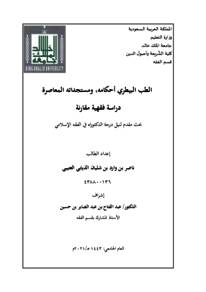دراسة وبائية وطفيلية ونسيجية مرضية على داء الاكياس المائية بين الحيوانات المحلية المذبوحة في جدة
SAMMARY Hydatidosis is one of the major zoonotic diseases that cause considerable economic losses and public heath problems worldwide . So the present study was conducted to assess the current status of hydatidosis among slaughter animals in Jeddah . Data on infection in inbres and imported camels , cattle, sheep and goats were collected 3 times / week for a long one year ( from January 2009 to January 2010) from North Jeddah abattoir louse . These data were statistically analysed. Parasitological examination was done on some randomly selected specimens of liver and lung , from different animals infected with hydatid cysts. This included the number of cysts/ organ, size of hydatid fluid and cyst fertility & viability. In addition , the ability of viable protoscolices , obtained from two different hosts (sheep and camels ) in causing infection was studied through experimental infection of Swiss Abino mice. Histopathological examination was also done on some hydatid cysts and some infected organs (liver and lung ). The results revealed that 1- A total of 91348 and 132858 inbred and imported animals were slaughterd. Sheep and goat were the most slaughtered animals. Indicating that the most humans consumption of meat in Jeddah is from sheep and goats. 2-The prevalence of hydatidosis among inbred animals revealed that sheep and goats were more infected (69.6% & 19.85% respectively ) than camels and cattle ( 6.86% & 3.63% respectively ). Differences in prevalence rates betweenB different animals were highly significant them. Indicating that sheep and goat are the most important intermediate hosts for E.granulosus this area. 3-The prevalence of infection among imported animals revealed that sheep and goats were the most infected (59.86% & 19.18% respectively ) than camels and cattle (2.13% & 18.82% respectively ) with high significant differences ( P›0.5) among them . 4- The prevalence of infection among inbred animals (1.36% %) was higher than the imported ones with high significant differences between them ( P›0.5). 5- The prevalence of infection to among the examined animals ( inbred and imported) varied significantly in relation to season. 6- The most commonly infected organs were liver and lungs among indigenous and imported animals. The livers was more infected than lung . 7- The range in the number of cysts / organ was 3-16 in all infected animals . 8 - The mean number of cysts was higher in the liver than that in the lungs in all examined animals. 9-Most of cysts have small size (having hydatid fluid less than 6 ml) and distributed more in liver than in lung , while the large cysts ( having hydatid fluid more than 20 ml ) were localized in the lung than in the liver . 10- The higher percentages of fertile cysts were in sheep (9.87 %) and goats (4.85 %) indicating that sheep and goats are the most important intermediate hosts for E.granulosus. 11 – The viability rate of protoscolices of liver fertile cysts ( 64.8 %, 61 %, 77.4 % , 86.2 % ) in camels , cattle , sheep and goats respectively was significantly higher than that of lung cysts ( 39.1 % , 55.5 %, 70.3 %) in camels ,C cattle and sheep respectively. 12 – The infection rates in the mice infected intraperitoneally with 0.2 ml of hydatid fluid containing ±2000 protoscolices aspirated from fertile cysts obtained from infected liver goat and infected lung camels were 75% ,11.1% respectively . All of cysts were in the peritoneal and abdominal cavities. 13-Histological examination of hydatid cysts showed that its wall consists of 2 layers: inner germinal layer and outer laminated layer : The wall is surrounded with fibrous capsule , which is infiltrated with inflammatory cells. Fertile cysts have scolices broad capsules or while the sterile ones have none . Some cysts were degenerated. 14- Histopathological examination of infected lung showed fibrosis of the alveolar ducts , shrunken alveoli (atelactasis) , distended alveoli ( emphysema), interstitial haemorrhage and scattered protoscolices among lung tissue. 15-Histopathological examination of infected livers showed loss of normal arichitecture , fatty degeneration of some hepatocytes , some have cloudy swelling and others were necrotic severe fibrosis of liver tissue , inflammatory cellular infiltration , sinusoidal dilation and scattered protoscolices among liver tissue were seen. In conclusion the low infectivity rate of hydatidosis among slaughtered animals, revealed increased public health among population and the strict laws from Jeddah province awareness. The findings of infection in slaughtered animals prompt plans for fur there epidemiological studies and control programs
